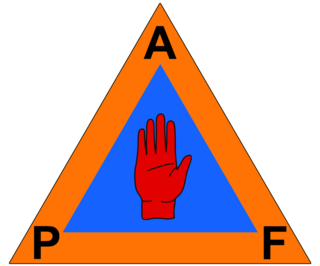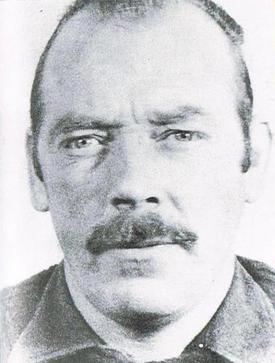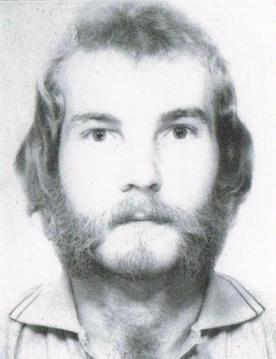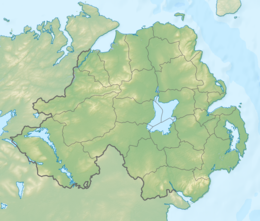Shooting
At 7:30 AM on 10 November 1990, the four men left home for Castor Bay on the shore of Lough Neagh for a wildfowling trip. Their early morning hunting excursions to the Department of the Environment-managed waterworks compound were routine and all of the men lived in the Lurgan and Waringstown areas. It is believed the IRA team were waiting for the group inside the compound and ambushed them shortly following their arrival. [4]
The victims were David Murphy, an RUC Special Branch Inspector; Thomas Taylor, a part-time RUC Reservist; Norman Kendall, an electrician and former UDR soldier; and Keith Dowey, an employee with the Department of the Environment water service and father of two young children. [5]
According to a 2000 report, the goal of the IRA unit, apparently members of the North Armagh Brigade led by the late Patsy Haughian, was only to abduct and interrogate Murphy about collusion between the RUC and loyalist militants, but things went wrong when Kendall and Dowey arrived to the scene in a car. Dowey, the driver, was shot and killed instantly, but there is evidence that Kendall put up some resistance before being slain. Taylor produced his personal weapon and shot at the assailants, but was cut down by a hail of fire. Murphy struggled and managed to avoid being bundled into the vehicle, but was eventually killed by Haugian. [6] After the hunting party failed to appear at lunch time the alarm was raised; it was initially feared they had been kidnapped but four bodies were accounted for. The gunmen escaped in one of the victim's cars which was later found partially burnt out at Brownlow Terrace, Lurgan. [4] The IRA unit then hid in a house on the shores of the lake before returning to Lurgan the morning after. [6]

The East Tyrone Brigade of the Provisional Irish Republican Army (IRA), also known as the Tyrone/Monaghan Brigade was one of the most active republican paramilitary groups in Northern Ireland during "the Troubles". It is believed to have drawn its membership from across the eastern side of County Tyrone as well as north County Monaghan and south County Londonderry.

The Irish People's Liberation Organisation was a small Irish socialist republican paramilitary organisation formed in 1986 by disaffected and expelled members of the Irish National Liberation Army (INLA), whose factions coalesced in the aftermath of the supergrass trials. It developed a reputation for intra-republican and sectarian violence as well as criminality, before being forcibly disbanded by the Provisional Irish Republican Army (IRA) in 1992.
This is a chronology of activities by the Provisional Irish Republican Army (IRA) from 1970 to 1979.
The Troubles in Armagh recounts incidents during The Troubles in Armagh City, County Armagh, Northern Ireland; the violence was substantial enough for a stretch of road on the outskirts of the city to be referred to by one RUC officer as "Murder Mile". Over the course of the Troubles, although mainly concentrated in the years from 1969 until 1994, the small city of around 15,000 people, including some outlying areas, saw 86 deaths, including those of a number of people from the city who lost their lives elsewhere in Troubles-related incidents.
The Troubles in Lurgan recounts incidents during the Troubles in Lurgan, County Armagh, Northern Ireland.

The Miami Showband killings was an attack on 31 July 1975 by the Ulster Volunteer Force (UVF), a loyalist paramilitary group. It took place on the A1 road at Buskhill in County Down, Northern Ireland. Five people were killed, including three members of The Miami Showband, who were one of Ireland's most popular cabaret bands.

The Protestant Action Force (PAF) was a cover name used by Ulster loyalist paramilitary group the Ulster Volunteer Force (UVF) when claiming responsibility for a number of attacks during the Troubles in Northern Ireland. Sometimes these actions were carried out with the assistance of members of the security forces. The name "PAF" was first used in 1974 and attacks by individuals claiming to be members of the PAF killed at least 41 Catholic civilians. All of the attacks claimed by the PAF in Armagh and Tyrone counties from 1974 to 1976 have been linked to the Glenanne gang, which was a loose coalition consisting of members of the UVF Mid-Ulster Brigade along with rogue Ulster Defence Regiment (UDR) soldiers and Royal Ulster Constabulary (RUC) police officers. A six-year period of no attacks claimed by the PAF ended in 1982; during the 1980s, the PAF claimed 15 attacks in the Belfast area and two in County Armagh. UDR soldiers were convicted of two attacks in Armagh. The PAF claimed its last attacks in the early 1990s, all of which were in north Armagh and were alleged to involve members of the security forces.
This is the Timeline of Irish National Liberation Army actions, an Irish republican socialist paramilitary group. Most of these actions took place as part of its 1975–1998 campaign during "the Troubles" in Northern Ireland. The INLA did not start claiming responsibility for its actions under the INLA name until January 1976 at which point they had already killed 12 people, before then they used the names People's Liberation Army (PLA) and People's Republican Army (PRA) to claim its attacks.

William Henry Wilson Hanna MM was a high-ranking Ulster loyalist who founded and led the Mid-Ulster Brigade of the Ulster Volunteer Force (UVF) until he was killed, allegedly by Robin Jackson, who took over command of the brigade.
This is a chronology of activities by the Provisional Irish Republican Army (IRA) from 1980 to 1989. For actions before and after this period see Chronology of Provisional Irish Republican Army actions.

The Glenanne gang or Glenanne group was a secret informal alliance of Ulster loyalists who carried out shooting and bombing attacks against Catholics and Irish nationalists in the 1970s, during the Troubles. Most of its attacks took place in the "murder triangle" area of counties Armagh and Tyrone in Northern Ireland. It also launched some attacks elsewhere in Northern Ireland and in the Republic of Ireland. The gang consisted of soldiers from the British Army's Ulster Defence Regiment (UDR), police officers from the Royal Ulster Constabulary (RUC), and members of the Mid-Ulster Brigade of the Ulster Volunteer Force (UVF). Twenty-five UDR soldiers and RUC police officers were named as purported members of the gang. Details about the group have come from many sources, including the affidavit of former member and RUC officer John Weir; statements by other former members; police, army and court documents; and ballistics evidence linking the same weapons to various attacks. Since 2003, the group's activities have also been investigated by the 2006 Cassel Report, and three reports commissioned by Irish Supreme Court Justice Henry Barron, known as the Barron Reports. A book focusing on the group's activities, Lethal Allies: British Collusion in Ireland, by Anne Cadwallader, was published in 2013. It drew on all the aforementioned sources, as well as Historical Enquiries Team investigations. The book was the basis for the 2019 documentary film Unquiet Graves, directed by Sean Murray.

Harris Boyle was an Ulster Defence Regiment (UDR) soldier and a high-ranking member of the Ulster Volunteer Force (UVF), a Northern Irish loyalist paramilitary organisation. Boyle was implicated in the 1974 Dublin and Monaghan bombings, and took part in the attack at Buskhill, County Down when an armed UVF gang wearing British Army uniforms ambushed The Miami Showband at a bogus military checkpoint. The popular Irish cabaret band was driving home to Dublin after a performance in Banbridge. He was one of the two gunmen killed when the bomb they were loading onto the band's minibus exploded prematurely. He is sometimes referred to as Horace Boyle.
John Oliver Weir is an Ulster loyalist born and raised in the Republic of Ireland. He served as an officer in Northern Ireland's Royal Ulster Constabulary's (RUC) Special Patrol Group (SPG), and was a volunteer in the illegal Ulster Volunteer Force (UVF). As a member of the UVF's Mid-Ulster Brigade led by Robin "the Jackal" Jackson, Weir was a part of the Glenanne gang, a group of loyalist extremists that carried out sectarian attacks mainly in the County Armagh area in the mid-1970s.
UVF Mid-Ulster Brigade formed part of the loyalist paramilitary Ulster Volunteer Force in Northern Ireland. The brigade was established in Lurgan, County Armagh in 1972 by its first commander Billy Hanna. The unit operated mainly around the Lurgan and Portadown areas. Subsequent leaders of the brigade were Robin Jackson, known as "The Jackal", and Billy Wright. The Mid-Ulster Brigade carried out many attacks, mainly in Northern Ireland, especially in the South Armagh area, but it also extended its operational reach into the Republic of Ireland. Two of the most notorious attacks in the history of the Troubles were carried out by the Mid-Ulster Brigade: the 1974 Dublin and Monaghan bombings and the Miami Showband killings in 1975. Members of the Mid-Ulster Brigade were part of the Glenanne gang which the Pat Finucane Centre has since linked to at least 87 lethal attacks in the 1970s.

The Coagh ambush was a military confrontation that took place in County Tyrone, Northern Ireland, on 3 June 1991, during The Troubles, when a Provisional Irish Republican Army (IRA) active service unit from its East Tyrone Brigade was ambushed by the British Army's Special Air Service (SAS) at the village of Coagh, in County Tyrone, whilst on its way to kill a part-time member of the Ulster Defence Regiment (UDR). The ambush resulted in the deaths of all three IRA men involved.

The Mullacreevie ambush took place on 1 March 1991, when a mobile patrol of the Ulster Defence Regiment composed of two Land Rover vehicles was attacked with an improvised horizontal mortar by a Provisional IRA active service unit from the North Armagh Brigade while passing near Mullacreevie housing estate, on the west side of Armagh City. One member of the UDR was killed instantly when the leading Land Rover was hit, while another died of wounds two days later. Two other soldiers were maimed for life.
This is a timeline of actions by the Official Irish Republican Army, an Irish republican & Marxist-Leninist paramilitary group. Most of these actions took place as part of a Guerrilla campaign against the British Army & Royal Ulster Constabulary and internal Irish Republican feuds with the Provisional IRA & Irish National Liberation Army from the early 1970s - to the mid-1970s during the most violent phase of "the Troubles" in Northern Ireland.

Throughout the protracted conflict in Northern Ireland (1960s-1998), the Provisional IRA developed a series of improvised mortars to attack British Army and Royal Ulster Constabulary (RUC) security bases. The organisation also purchased both light and heavy machine guns in order to hamper the British Army supply of border bases by helicopter. The IRA fitted vehicles, specially vans and trucks, with both types of weapons. Vans, trucks and tractors were modified to transport concealed improvised mortars to a launch area near the intended target and fire them, while light and heavy trucks were employed as firing platforms mounting machine guns, particularly M60s and DShKs. Improvised armoured vehicles and heavy equipment were also used to penetrate the perimeter of fortified security bases. The IRA vehicles were often disguised as belonging to civilian companies or even government agencies.

On 12 December 1993, a unit of the Provisional Irish Republican Army's (IRA) East Tyrone Brigade ambushed a two-men unmarked mobile patrol of the RUC in Fivemiletown, County Tyrone. Two constables were shot and killed instantly. A military helicopter was also fired at by a second IRA unit in the aftermath of the incident, during a follow-up operation launched in the surroundings of the town by both the British Army and the RUC. A number of suspects were questioned, but the perpetrators escaped successfully. The action occurred just three days before the Downing Street Declaration.
This is a chronology of activities by the Provisional Irish Republican Army (IRA), in 1990 and 1991.












